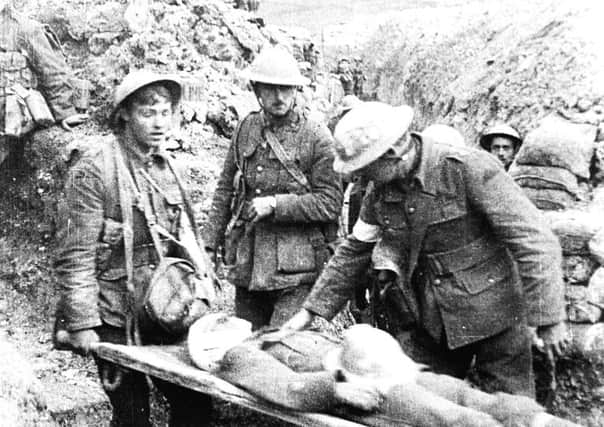Forget Brexit, it's how we mark the Somme centenary which will define us as a nation


How we commemorate the ‘lost generation’ will define us as a nation
This week, Britons will commemorate one of the darkest chapters in our military history as we mark the centenary of the Battle of The Somme. The battle, which raged for 141 days from 1st July to 18th November 1916, has come to symbolise the waste and the tragedy of the entire war.
Advertisement
Hide AdAdvertisement
Hide AdAll those who experienced the battle have now gone to their graves and it lives on only in museums, school books, and in folk and family memories. As the nation’s custodian of Remembrance, The Royal British Legion has a unique role to ensure the Somme holds a special place in our nation’s story – it was the first time that ‘Pals battalions’, including those from Yorkshire, were largely tested in battle and the first time they suffered losses on such a terrible scale.
Men from across the county joined 15 Battalions, including Leeds City Pals, Sheffield, Barnsley, Bradford and Hull Sportsmen Green Howards. Leeds, like many other cities and towns, found men keen to sign up to fight in a war that they believed would be over by Christmas. By September 1914 enlistment to the Leeds Pals stood at 1,275. Raised in towns, villages, workplaces and sports clubs, the Pals joined together, trained together, went into battle together and, sadly, often died together. There is no doubt that Kitchener’s Volunteer Army, organised in this way, was disastrous for the communities from which they came.
Now in 2016 the Legion is calling on communities across the country to come together and commemorate the Battle of the Somme which, to this day, represents the heaviest losses in the history of the British and Imperial Armed Forces.
The first day of the Battle of the Somme is remembered as the bloodiest in British military history with 57,470 casualties, of which 19,240 were killed; this will be the focus of national and international commemorations on 1st July. However it was the battle’s impact over the 141 days that was felt so sharply with the hopes of entire towns, families, and sweethearts left in ruin. Testament to this fact are the names on village war memorials, the countless local rolls of honour and the many plaques that adorn the walls of sports clubs and places of business, all of which pay tribute to the brave young men who went off in groups of pals never to return.
Advertisement
Hide AdAdvertisement
Hide AdTo aid the war effort, virtually all professional sport had been suspended for the duration by the time the Battle of the Somme began and the overwhelming majority of the UK’s communities sacrificed scores of their young men who had enlisted in other local battalions, some suffering a complete loss, often in a single day.
Athletes and players from sports at all levels volunteered to enlist and there were battalions – like the Green Howards – that included significant numbers of athletes, footballers, and individual members of clubs and teams. Major William Booth (Major being his first name and not a military rank) was one such athlete from Pudsey. Along with fellow Yorkshire County Cricket teammate Roy Kilner, Booth enlisted as a private in the 15th Battalion of the West Yorkshire Regiment, 31st Division. The talented 2nd Lt Major Booth, as he had become, was eventually fatally wounded by shrapnel and died in the arms of fellow Yorkshire cricketer, Abe Waddington.
From Bradford there were two Pals battalions, the first of which was raised in a matter of weeks in September 1914, sustained by the initial enthusiasm among local men to serve their country. On 1st July more than 2,000 Bradford Pals attacked across No Man’s Land and by lunchtime, 1700 of them had been killed, wounded or captured. Alongside their fellow Northern battalions at Serre, the Leeds Pals suffered heavily on 1st July at the hands of the German machine guns. By the end of their attack, 13 officers and 300 other ranks were dead; another Northern town that learned the cost of the Big Push of 1916.
The Somme was, by and large, felt locally and to help communities in Yorkshire and across the UK observe the commemoration locally, the Legion has created Remember the Battle of the Somme 1916-2016. This is a programme of events and tools to assist people in their acts of Remembrance, including commemorations of the sportsmen who gave their lives at the Somme. Partnering with television historian Dan Snow, the Legion has also created a free mobile and tablet app featuring more than 250 pieces of multimedia content which bring to life key moments from the battle.
Advertisement
Hide AdAdvertisement
Hide AdRemembrance acts powerfully on the spirit and on the emotions, moving us both as individuals and as communities. The poppy is a symbol of Remembrance and hope and in this centenary year, the Legion wants to see thousands of scattering poppy petals in commemoration of those who fell at the Somme. The world is a very different place than in 1916, but we can continue to hope that no village or town will ever again be asked to say goodbye to so many.